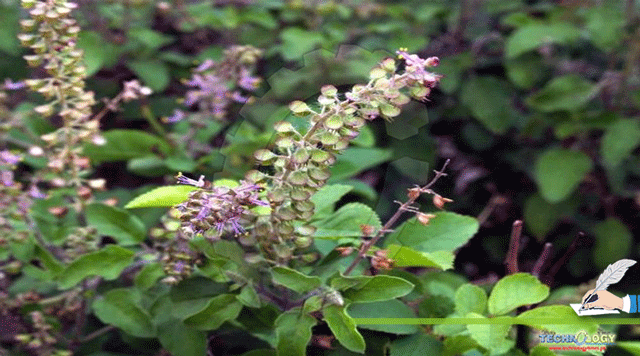Plants are the most crucial origin of the medicines, chemical and bioactive compounds, having beneficial effects. Phenolics, alkaloids, flavonoids, essential oils, glycosides, tannins steroids, saponins are the constituents of bioactive phytochemicals present in the plants used in the pharmaceutical industry. The medical practitioners have been used the medical plants on account of these advantages. The prehistoric physicians recorded the therapeutic properties of the medicinal plants are recorded empirically in Ayurveda (a natural medicinal system).

By: Saima asghar, Maria Naqve, Safura Bibi, Athar Mahmood
Ocimum sanctum (Tulsi), a sanctified and conventional medicinal plant, belongs to the Lamiaceae family, esteemed as the “Elixir of Life” due to multifarious health benefits.
Morphology of Tulsi Plant
Tulsi plant is erect, 30-60 cm in length, branched, opposite green leaves and hairy stem. Leaf color varies from the light green to dark purple. Purplish flowers are present in close whorls in elongate racemes.
O. sanctum L. grows in low bush form and is called as the holy basil, tulasi or tulsi. Following are the important species of tulsi:
- · Dark Tulsi or Shyama (Ocimum sanctum)
- · Vana Tulsi (Ocimum gratissimum)
Nutritional Value
Contain vitamin A and C, chlorophyll, minerals such as zinc, calcium and iron and also other phytonutrients. Carbohydrate 2.3 g, Fat: 0.5 g, Protein: 4.2 g, Iron: 15.1 mg, Phosphorus 287 mg, Calcium: 25 mg.
Dosage:
- Root decoction: 50ml to 100 ml
- Seed Powder- 3ml to 6 ml
- Fresh juice-10ml to 20 ml
- Depression and anxiety can be reduced by using 500mg of the leaf extract, twice a day.
- Central nervous system (CNS) disorders can be eased by using 300 milligrams of the leaf extract in 30 days.
- Stress symptoms; severe fatigue, memory problems, sleep, can be decreased by using 400 milligrams of the leaf extract in morning and about 800 milligrams at night in duration of six weeks.
Medicinal value Of Ocimum sanctum
Ocimum sanctum as Anti-diabetic agent:
Diabetes mellitus, a metabolic disease indicated by hyperglycemia, correlated with the disruption in protein, carbohydrates and the lipid metabolism, associated with complexities i.e., diabetic neuropathy, nephropathy and retinopathy.
The ethanolic extractions of the leaves of O. sanctum enhances insulin level, glucose tolerance and in diabetic rats ultimately resulted in reduction of uronic acid, fasting the blood glucose and improves lipid profile by reducing the rising level of amino acids, Triglycerides (TG), Cholesterol (TC) and Phospholipids. The pretreatment with the leaves of O. sanctum in the STZ-induced diabetic rats resulted in hypoglycemic level by reducing the increasing blood glucose levels and maintaining lipid profile. In alloxan, reduced diabetic rats, the administration of cholesterol fraction, petroleum ether, ethyl acetate of O. sanctum should enhance the insulin level via modification in the metabolizing carbohydrate enzymes by insulin sensitizing receptors.
Phytochemicals constituents such as flavonoids, triterpenes and saponins were accountable for the hypoglycemic effect. The regime of extracts of O .sanctum controls the diabetic complications via its antioxidant pursuit by decreasing thiobarbituric acid reactive substances (TBARS) plasma level and maintaining antioxidant markers such as glutathione peroxidase, catalase and superoxidase dismutase (SOD).

ATP demonstrates adenosine triphosphate, AST demonstrates aspartate aminotransferase, LDL demonstrates low density lipoproteins, ALT demonstrates alanine amino transferase and HDL demonstrates high density lipoproteins.
Ocimum sanctum as Anticancer:
Cancer, a major cause of mortality and morbidity spread mainly in the developed countries. Cancer happens because of abnormal cell division, grows and further spread to the other body parts via an extra additional tissue mass known as tumor. Lack of physical activity, infections, obesity, tobacco, environmental pollutants and radiations are the main factors due to which risk of cancer increases.
Numerous natural and synthetic compounds such as methotrexate, dacarbazine, busulfan, Tulsi (Ocimum sanctum), turmeric (Curcuma longa), ginger (Zingiber officinalis) etc. found to be beneficial in the treatment of various types of cancer.

The anticancer effect of methyl-N-nitro-N-nitroguanidine (MNNNG) suppresses gastric carcinoma via down regulation of antiapoptotic protein (Bcl-2), and up regulation of proapoptotic protein (Bax), caspase and cytochrome C.
Moreover, administration of ethanolic leaf extractions of O. sanctum Confirms the antitumor activity by suppressing phosphorylation of protein kinase (BAKt) and extracellular signal regulated kinase (ERK) and influencing proapoptotic protein Bax/ antiapoptotic protein Bcl-2 ratio. This suppression activates P53, ultimately activates proapoptotic signaling traces for lung cancer in animal models and for A549 cancer cells in humans.
Furthermore, leaf extractions of O. sanctum containing essential oils exert apoptotic and cytotoxic activities to colorectal adenocarcinoma cells COLO205 in humans by suppressing proliferation and angiogenesis.
A flavonoids, Vicenin-2, present in the leaves of O. sanctum posses proapoptotic, antiangiogenic and antiproliferative property an in the carcinoma of prostate cells via suppressing p70S6k pathway/ mTOR (mammalian target of repamycin)/ Akt(protein kinase B)/ EGFR (epidermal growth factor receptor) thereby limiting the CDK4, cyclin D, cMyc, cyclin B1 and the proliferating cell nuclear antigen PCNA. The myricitin (flavonoids) and apigenin occurring in the O. sanctum forms apoptosis in the HL-60 leukemic cells through several mechanisms like caspase-3 inhibition, proteolytic division of poly ADP-ribose polymerase (PARP), loss of the mitochondrial transmembrane activities and enhancing progeny of the reactive oxygen species (ROS).
The detoxifying mechanisms of enzymes such as glutathione S-transferase-Pi (GST-Pi), aryl hydrocarbon hydroxylase and cytochrome p-450 are increased along with the application of leaf extractions of O. sanctum, control carcinogenesis.
It was deduced that the traditional medicines are safe and having numerous therapeutic applications. O. sanctum is an important medicinal plant having multiple pharmacological applications. That is why, due to its efficacy and applications O. sanctum is known as “Elixir of Life”.
Authors: Saima asghar, Maria Naqve, Safura Bibi, Athar Mahmood. University of agriculture Faisalabad